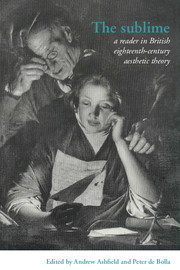Book contents
- Frontmatter
- Contents
- List of Abbreviations
- Introduction
- Part I The Longinian tradition
- Part II Rhapsody to rhetoric
- 11 The spectator, (1712-1714)
- 12 A discourse on ancient and modern learning (1734)
- 13 Characteristicks (1714)
- 14 The works (1724)
- 15 To David Fordyce, 18th June 1742
- 16 The pleasures of imagination (1744)
- 17 An essay on the sublime (1747)
- 18 Observations on man (1749)
- 19 Lectures on the sacred poetry of the Hebrews (1753/1787)
- 20 A dictionary of the English language (1755)
- 21 Conjectures on original composition (1759)
- 22 The art of speaking (1761)
- 23 A course of lectures on oratory and criticism (1777)
- 24 An enquiry concerning the principles of taste (1785)
- Part III Irish Perspectives
- Part IV The Aberdonian Enlightenment
- Part V Edinburgh and Glasgow
- Part VI From the Picturesque to the Political
- Sources and further reading
22 - The art of speaking (1761)
Published online by Cambridge University Press: 05 June 2012
- Frontmatter
- Contents
- List of Abbreviations
- Introduction
- Part I The Longinian tradition
- Part II Rhapsody to rhetoric
- 11 The spectator, (1712-1714)
- 12 A discourse on ancient and modern learning (1734)
- 13 Characteristicks (1714)
- 14 The works (1724)
- 15 To David Fordyce, 18th June 1742
- 16 The pleasures of imagination (1744)
- 17 An essay on the sublime (1747)
- 18 Observations on man (1749)
- 19 Lectures on the sacred poetry of the Hebrews (1753/1787)
- 20 A dictionary of the English language (1755)
- 21 Conjectures on original composition (1759)
- 22 The art of speaking (1761)
- 23 A course of lectures on oratory and criticism (1777)
- 24 An enquiry concerning the principles of taste (1785)
- Part III Irish Perspectives
- Part IV The Aberdonian Enlightenment
- Part V Edinburgh and Glasgow
- Part VI From the Picturesque to the Political
- Sources and further reading
Summary
A correct speaker does not make a movement of limb, or feature, for which he has not a reason. If he addresses heaven, he looks upward. If he speaks to his fellow-creatures, he looks round upon them. The spirit of what he says, or is said to him, appears in his look. If he expresses amazement, or would excite it, he lifts up his hands and eyes. If he invites to virtue and happiness, he spreads his arms, and looks benevolence. If he threatens the vengeance of heaven against vice, he bends his eyebrow into wrath, and menaces with his arm and countenance. He does not needlessly saw the air with his arm, nor stab himself with his finger. He does not clap his right hand upon his breast, unless he has occasion to speak of himself, or to introduce conscience, or somewhat sentimental. He does not start back, unless he wants to express horror or aversion. He does not come forward, but when he has occasion to solicit. He does not raise his voice, but to express somewhat peculiarly emphatical. He does not lower it, but to contrast the raising of it. His eyes, by turns, according the humour of the matter he has to express, sparkle fury; brighten into joy; glance disdain; melt into grief; frown disgust and hatred; languish into love; or glare distraction.
- Type
- Chapter
- Information
- The SublimeA Reader in British Eighteenth-Century Aesthetic Theory, pp. 116 - 118Publisher: Cambridge University PressPrint publication year: 1996



